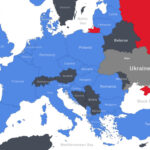Despite sanctions and the war in Ukraine, Russia’s military appears to be getting stronger, not weaker. Amy Mackinnon reports in Foreign Policy:
Two years after Russia launched its full-scale invasion of Ukraine, the Kremlin is restructuring and expanding the country’s military in anticipation of a conflict with NATO within the next 10 years, Estonia’s foreign and military intelligence chiefs said in an interview on Wednesday.
Contrary to Russian President Vladimir Putin’s expectation of seizing the Ukrainian capital, Kyiv, in a matter of days, the first months of the invasion revealed profound shortcomings in Russian military planning as poorly equipped troops foundered in the face of fierce resistance by the Ukrainian armed forces. Experts as well as U.S. and foreign officials were quick to declare the Russian army a paper tiger.
“The Kremlin often claimed it had the second-strongest military in the world,” U.S. Secretary of State Antony Blinken said in a speech last June. “Today, many see Russia’s military as the second-strongest in Ukraine.”
But as the war enters its third year, Putin is looking increasingly confident. His main political rival, Alexei Navalny, is dead; vital U.S. military aid to Ukraine is stalled in Congress; and Russia has shifted its economy to a war footing, fueling defense production and economic growth in defiance of international sanctions.
“Everything is more or less going to the plan again” for Russia, said Kaupo Rosin, the director-general of the Estonian Foreign Intelligence Service (EFIS), during a meeting with a small group of journalists in Washington.
Russian military leaders have learned from the mistakes of the opening phases of the war and are adapting with uncharacteristic speed. “It seems that the Russians are, in principle, turning into a learning organization in the military,” said Rosin, who added that they were now resolving problems encountered on the battlefield within a matter of months.
The Ukrainian armed forces have impressed Western military leaders with their ability to innovate on the battlefield and adapt to new technologies, which has given them an edge against a larger and better-equipped adversary. Russia’s centralized control structure is slow to learn, but when it does, “it is able to systematize it across the military and through its large defense industry,” retired Australian Army Maj. Gen. Mick Ryan wrote in Foreign Affairs in February.
“The Russians, according to our understanding, have always fixed their issues or problems through mass. And this has worked out for them throughout history,” said Rosin, adding that reforms to the Russian armed forces were likely to result in a low-tech, Soviet-style army with “a lot of firepower and artillery.”
In late 2022, Russian Defense Minister Sergei Shoigu announced plans to overhaul the structure of the country’s armed forces and expand its personnel by 30 percent, to 1.5 million people, by 2026. The Kremlin’s “highest priority for force generation lies in the Western strategic direction and Ukraine,” EFIS noted in its public annual report, published in February.
In light of Finland’s accession to NATO, which doubled the military alliance’s shared border with Russia, Moscow may look to double the nearly 19,000 troops it had stationed at its western borders before the invasion of Ukraine, the report added. Since that report was published, Sweden has also formally joined NATO.
The Russian reforms have been accompanied by a significant boost in military spending, with defense set to account for one-third of all government spending this year, while arms manufacturers have been urged to work around the clock.
Read more here.






